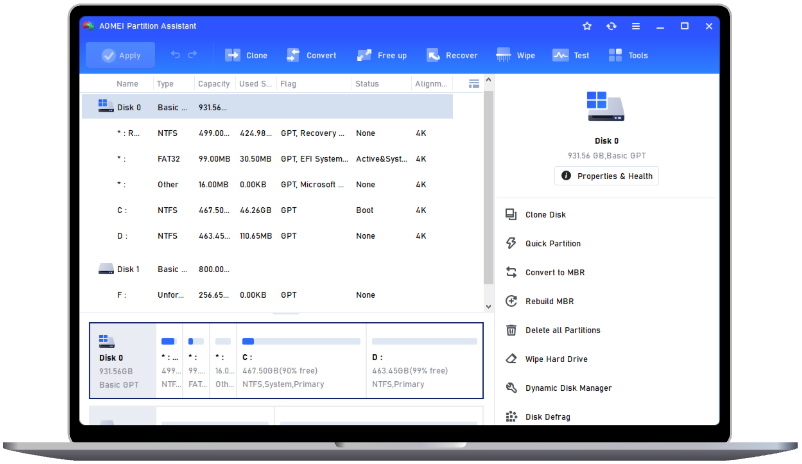How Long Does It Take to Shrink a Partition? Discover an Efficient Way
How long does it take to shrink a partition? The process varies depending on several factors, such as partition size, disk type, and the tools used. This article provides more details and helps you shrink partitions more efficiently.
Partition shrinking is a practical operation for disk management, but sometimes it might take too long or even fail to complete. This article will explore the causes behind inefficient resizing and provide an alternative way to shrink your partitions efficiently.
How long does it take to shrink a partition?
Before discussing how long it takes to shrink a partition, let's first understand what partition shrinking is. Shrinking a partition means reducing its size to match the amount of used space, freeing up much space for other purposes. This process usually involves moving files within the partition, adjusting the file system, and reallocating space.
So, how long does it take to shrink a partition? The time required depends on several factors, such as partition size, disk type, resizing tools, and more. The more complex the situation, the longer the shrinking process will take. On average, it typically takes 15 to 20 minutes, but in some cases, it may take a few hours. The exact duration depends on the factors mentioned.
Why does shrinking a partition take so long?
Here are the main reasons why partition resizing may take longer than expected:
➤ If the partition contains a large amount of data, the system needs to move and reorganize a significant amount of information, which increases the time required.
➤ Some system files, usually located at the end of the partition, cannot be moved. These unmovable files can slow down the shrinking process or even cause it to fail.
➤ If there isn't enough free space to perform the resize, the system may need to clear enough room first. This process can take additional time.
➤ The type of disk also affects resizing speed. For example, shrinking an HDD takes longer than resizing an SSD due to the mechanical nature of HDDs.
➤ Issues such as bad sectors or a corrupted file system can delay the shrinking process, as the system attempts to fix these errors before continuing.
How to fix resizing partitions taking too long?
This section offers several solutions to fix resizing partitions that are taking too long. Select the one that best suits your needs.
Solution 1. Move Pagefile to Another Location
Since unremovable data on the volume can increase the shrinking time, you can move them to another place before starting the process. Follow these steps to move the Pagefile to another location:
Step 1. Press Win + R to open the Run window, type control, and press Enter.
Step 2. In the Control Panel, click System > Advanced system settings.
Step 3. Under the Advanced tab, click Settings in the Performance section.
Step 4. In the pop-up window, click Change under the Advanced tab.
Step 5. Uncheck the option “Automatically manage paging file size for all drives”.
Step 6: Select a different drive to save the pagefile, then set the paging file size to System managed size.
Step 7: Click Set > OK to apply the changes; then restart your computer.
Solution 2. Disable Hibernation Mode
Hibernation mode uses hiberfil.sys to save the contents when the computer hibernates. This file can be large and is typically located at the end of the partition, making it difficult to move during the shrinking process. By disabling this mode, the system will delete the hibernation file, freeing up space and making the shrinking process faster.
Step 1. Press Win + R to open the Run window, type control, and press Enter.
Step 2. Click Power Options in the Control Panel.
Step 3. In the left panel, select Choose what the power button does.
Step 4. Click Change settings that are currently unavailable in the pop-up window.
Step 5. Finally, uncheck the Hibernate box and click Save changes.
Solution 3. Delete System Restore Points
System Restore Points are large files that store backup copies of system settings and files, which can take up significant space on the partition. You can delete old or unnecessary restore points to speed up the partition-shrinking process.
Step 1. Press Win + R to open the Run window, type cleanmgr, and then press Enter.
Step 2. In the pop-up window, select the drive where your system restore points are stored and click OK.
Step 3. Click Clean up system files to proceed.
Step 4. Switch to the More Options tab and click Clean up in the System Store and Shadow Copies section.
Step 5. In the prompted window, click Delete to confirm the operation.
Solution 4. Check Disk Errors
Sometimes, you can't shrink the partitions in Windows 10 because there are file system errors on your disk. Follow these steps to check and repair these errors:
Step 1. Press Win + R to open the Run window, type cmd, and then press Enter.
Step 2. Type the following command and press Enter.
chkdsk x: /f (Replace x with the letter of the partition you want to check.)
Step 3. CHKDSK will check and repair disk errors automatically.
An Efficient Way to Shrink Partitions on Windows PCs
AOMEI Partition Assistant is a professional and efficient solution for resizing partitions while maintaining data integrity. It stands out with a wide variety of tools that simplify PC disk partition management. By simply dragging the dots at the beginning or end of the partition, you can effortlessly shrink and expand partitions on both NTFS and FAT32 file systems across Windows 11, 10, 8, 8.1, and 7.
With this tool, you no longer need to worry about issues like "How long does it take to shrink a partition?" or "Why is resizing a partition taking so long?", as it ensures an excellent user experience, making partition management smoother than ever before.
Follow these steps to efficiently shrink a partition without losing data using AOMEI Partition Assistant:
Step 1. Install and launch AOMEI Partition Assistant; then right-click the partition you want to shrink, and select the 1-Click Adjust Space option.
Step 2. This software allows you to adjust partition size by dragging the dot. For example, if you want to reduce the partition F: and expand the partition D: at the same time, drag the dot to the right and click OK to proceed.
Additionally, you can drag the dot near the partition C: tail forward to shrink the partition C: so the D: will also be enlarged with the space of C: at the same time.
Step 3. After setting the desired adjustments, preview the changes in the Pending Operations window. Then click Apply and Proceed.
Step 4. Wait for the operation to be finished. It may take a few minutes. Once complete, you will find D: is enlarged and both D: and F: are adjusted.
Final Words
In this post, we discussed how long it takes to shrink a partition and how to fix resizing a partition taking so long. For a more efficient shrinking process, it is recommended to use professional partition software like AOMEI Partition Assistant, which allows you to adjust partition space efficiently and flexibly.


